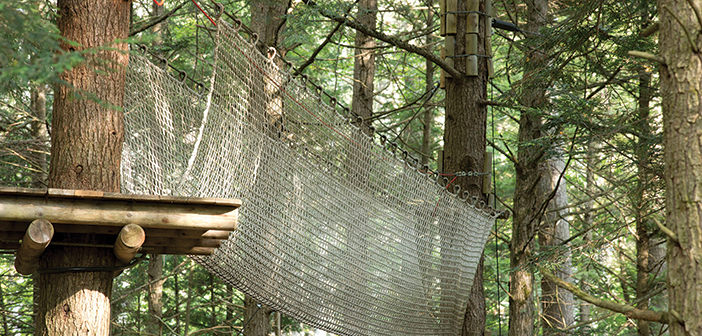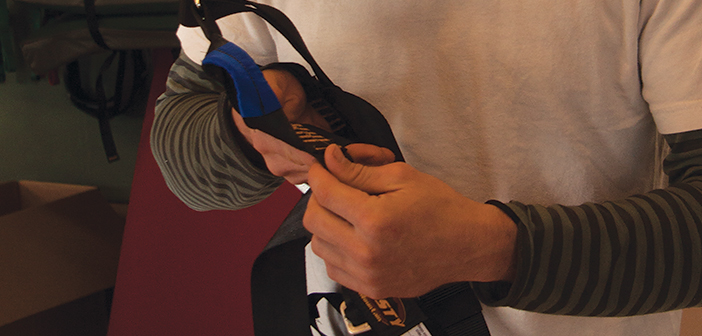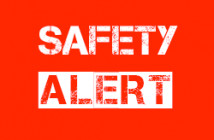It’s 7:15 p.m., and the last guest of the season—brow damp with sweat, Cheshire Cat grin across her face—exits the final zip. The long aerial adventure season is finally over, and the thought of checking out and enjoying the off-season feels awfully good after the hectic pace and long days of the previous few months. The temptation is strong to simply lock the doors and head for the hills.
However, before settling in for that long winter’s nap, it’s wise to invest the extra time needed to close operations in a way that sets the stage for a successful (read: less stressful and less expensive) opening in spring. Thinking ahead now can save a lot of money and heartache later. I can say this with such confidence because—just like licking a frozen flagpole—we’ve learned the hard way. After seven years of operating a commercial aerial adventure park, we’ve learned a great deal about how to avoid leaving our taste buds on the frozen steel.
As with most things, having a plan is a great help. We’ve found that the items needing attention when closing up for the season fall into seven distinct areas, which are relatively universal for most operations.
1. The Course
This is the star of the show for our businesses. In most instances, the course is the primary reason people show up and give us money. And all courses take a beating during a busy season. Chances are, lots of small issues accumulate over the course of a summer (frayed element ropes, worn wooden components, etc.). Due to the pace of high season, those items generally get put on the “fix it when we get time” list. This is one of the easiest places to start in preparing for closing.
• List all needed repairs. Regardless of whether you do your own repairs or have a vendor that makes repairs for you, no work can really begin without a thorough list of items that need attention.
• Do a walkthrough. Many of those items should be noted on the daily inspection reports that (hopefully!) your qualified personnel execute prior to opening every day. However, it’s hard to beat a thorough end-of-season walkthrough to note all the little things that need to be addressed, as well as the more critical structural and arboreal issues that may have developed.
• Schedule the repairs. Once you have a list, ensure that the qualified entity that is designated to make the repairs has an adequate window of time to get the work done. Putting off the walkthrough—and even the repairs—until early spring, when the entire industry gets busy, will likely cause unnecessary stress. This is especially true if you rely on a professional vendor to take care of all your repair work.
• Recertify equipment now. In addition, some items on your course, such as auto belays and some zip line braking components, may require periodic recertification, which necessitates removal, shipment, and reinstallation prior to use in the next season. Waiting until spring when EVERYONE is scrambling to get courses ready for opening is the worst time to get on a company’s recertification schedule. If you won’t be operating your course for several months, take the units down, send them in for recertification, and then keep them stored over winter to be reinstalled after your annual preseason professional inspection. You’ll avoid the spring rush and have the added benefit of saving your units several months of exposure to the elements.

Course elements take a beating. Do a thorough walkthrough of the course shortly after closing and create a list of all needed repairs so work can be scheduled in a timely fashion. Credit: Adirondack Extreme.
2. Participant Gear and Equipment
Participant gear—including harnesses, helmets, lanyards, as well as zip trolleys, carabiners, and belay connectors on a commercial tour—takes its share of abuse. With thousands of hands and bodies coming into contact with it through the course of the season, each piece can get pretty grimy and worn.
• Clean and wash. At the end of the season we typically wash all of our soft goods according to the manufacturer’s recommendations, and then let them dry thoroughly prior to storing them.
• Inspect and repair. Everything also gets a close inspection. Any units that need attention (i.e. elastic keeper straps that need mending, etc.) get set aside for repair or for further inspection by a qualified person if there is damage or wear beyond simple cosmetics.
• Take inventory. Through this process we also do inventory, so that we know how many pieces of gear will need to be replaced. This gives us budget data leading into the following season, and also gives us time to order and pay for gear before the end of the year, which may have positive tax implications.
• Store securely. One thing to keep in mind when storing gear over the winter is—like us humans—mice and other furry friends seek shelter from the harsh weather conditions. Apparently, nylon is a spectacular material for making cozy nests. Therefore, when storing items such as harnesses, ropes, and lanyards, make sure potential nest builders cannot touch them. If harnesses and other items hang, keep them well off the floor. And don’t fool yourself with the illusion that storing said items in a standard snap-lid plastic bin is the solution. It’s not. Ask me how I know.
3. Staff Gear and Equipment
Like participant gear, staff gear needs a thorough inspection, cleaning, evaluation, and documentation at the end of the season.
• Documentation. Really? Yep. Staff gear inspections need to be logged on an ongoing basis to be compliant with OSHA requirements.
• Stay current with OSHA. OSHA compliance for your course is a subject for a different article, but it’s something that operators should invest the time and resources to learn about. If it’s not something that you’ve historically understood or paid attention to, the end of the season is the perfect time to board the compliance train.
4. Office Equipment
• General cleanup and inspection. While you’re neck deep in cleaning and throwing things out, inspect radios, tablets, charger cords, computers, paper printers, credit card scanners, receipt printers, cash drawers, etc. All need to be assessed, fixed, and possibly replaced before the next season starts. Nothing is more annoying to a returning staff than to start a new season with the same old only-kinda-working equipment that they limped to the finish line with last season. Check it out, make a list, and get the stuff fixed or replaced while it’s fresh in everyone’s mind.
• Buy and act on extended warranties. Here’s some free advice you’ll thank me for if you heed it: if you purchase electronics online, always get the Square Trade or whatever item replacement program that’s offered. Why? Because even if you put the tablets used for check-in or online waivers in those cool, rugged, rubber cases—heck, even military spec armor—some little minion will still find a way to bounce it off his little sister’s head and crack the screen. If you have the protection, just send the tablet back for a new one. Mischief, managed.
5. Facilities
• Clean and inspect. Places where people gather on a daily basis will need some attention, such as check-in areas, gear-up areas, demonstration areas, ticketing and merchandise areas, guide break rooms, etc. They normally endure wear, tear, and a general accumulation of “stuff” through the course of a busy season. All will benefit from a general cleaning and de-cluttering.
• Clear out the area. Make one last call for the items in the lost and found, and then either chuck the stuff in the circular file, donate it, or offer it up to the highest bidder. Whatever the case, get rid of the junk at the end of the season and get all the spaces—especially indoor spaces—tidied up so a mess isn’t waiting for you in March.
• Itemize and make repairs. Any big structural or cosmetic issues with buildings, grounds, and infrastructure should also be noted and addressed. If you don’t own the property, but lease or license space on someone else’s facility, they will need detailed information and lead time in order to make repairs before next season. So, if you want that annoying roof leak in the gear room fixed prior to the inevitable April showers, best let the landlord know in November.
6. Personnel
• Take stock. Staffing for the following season is a commonly overlooked consideration while in the process of closing up. However, this is a critical time to take stock of how many experienced staff will be returning and how many newbies you’ll have to drum up in the month prior to opening next spring.
• Evaluations and reviews. Typically, we use this time to do staff evaluations for those who have served the entire season, and discuss their intent to return the following year. We also discuss promotions or pay raises if it’s appropriate to the situation. Some companies have incentive programs that pay bonuses at the end of the season, so this is a great opportunity to have those conversations and maybe even have an end-of-season party.
• Engage staff in the shut-down process. If you’ve already taken care of evaluations and incentives, keep your best staff around for an extra week anyway and engage them to help with the process of closing up properly. It’s a good way to not only lighten the load on management, but also build rapport and get some valuable feedback from them about the season.
• Schedule spring job fairs and postings. While you’re thinking about staffing for next year, be sure to put an event on your calendar for at least six weeks ahead of opening that reminds you to post your job listings so you’re not scrambling to assemble potential staff for training. ZipRecruiter.com is a great site that has borne a lot of fruit for us. (Ed. note: consider the classifieds at adventureparkinsider.com, too.)
7. PR, Marketing, Merchandising
• Evaluate PR/marketing spend and effectiveness. Your marketing should be something that you keep track of and make necessary adjustments to throughout the summer, but at the end of the season you can add it all up. Review your PR/marketing spend and evaluate what worked, what didn’t, and what makes the most sense for the following season. If you don’t already have a system that quantifies the success of your marketing efforts, establishing such a system should be at the top of your winter to-do list.
• Inventory, order promotional items. Do a thorough inventory of leftover logo items and other merchandise to see what sold, what didn’t, and determine purchasing needs for the upcoming season. If you do this early enough and have time to make the merchandise order before the end of the year, you can stock up for next year on this year’s taxes.
In the end, it’s really all about resisting the strong (and well-earned) temptation to just close the door and run when the busy season is over. By finding the energy and focus to cross everything off your list before turning the lights out, you’ll make the opening process in spring so much easier. And that extra peace of mind will make your long winter’s nap a whole lot sweeter.





